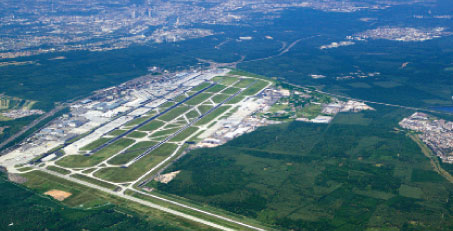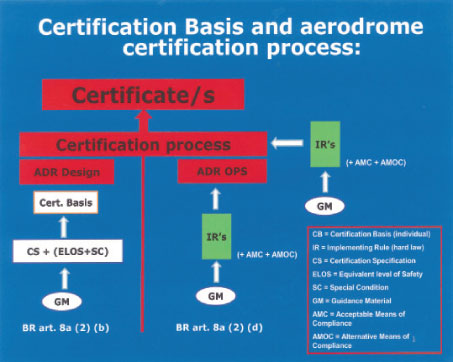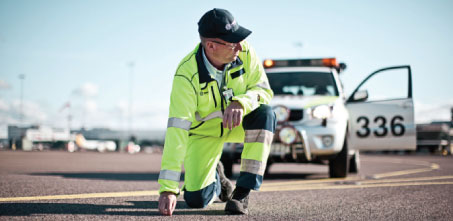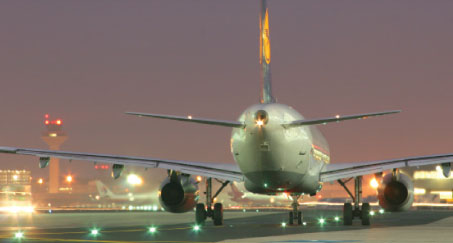
Image courtesy of Fraport.
Following its mandate by the European legislator, the preparation of the implementing rules (IR) for aerodrome safety is running at full speed. Formal EASA Rulemaking Groups for this area cover authority and organisation requirements (ADR.001), aerodrome operations (ADR.002) and aerodrome design (ADR.003). These groups are composed of and chaired by experts chosen from amongst national authorities and the airport industry. Since July 2010 six large three-day meetings of all groups and several intermediate meetings have taken place. The Rulemaking Groups will deliver the core material, the implementing rules (IRs, ‘hard law’) and certification specifications (CSs, ‘soft law’) – for their respective areas by the end of July 2011. It will also be endeavoured to provide as much of the necessary Acceptable Means of Compliance (AMCs) and Guidance Material (GM) in July.
 In the following we summarise briefly the progress of the project. We also introduce the concept of the Certification Basis (CB), which is a description of an aerodrome facility’s design and infrastructure in terms of the regulatory certification specifications (CS) that it complies with. It is the cornerstone of an aerodrome’s certification process.
In the following we summarise briefly the progress of the project. We also introduce the concept of the Certification Basis (CB), which is a description of an aerodrome facility’s design and infrastructure in terms of the regulatory certification specifications (CS) that it complies with. It is the cornerstone of an aerodrome’s certification process.
Work in progress
All the rules on aerodrome safety, including those on authorities and aerodrome operator organisations, will be ‘stand alone’. This means that they are likely to be placed in one single annex to a Commission Regulation. One single book will also contain the certification specifications, and thus the greater part of the transposed ICAO Annex 14.
By the end of July 2011 the first two groups (ADR.001 and ADR.002) will deliver to the EASA team their proposals for the aerodromes rules. The group on aerodrome design will deliver the proposed CS and GM. EASA will then endeavour to evaluate and aggregate the results and to make sure that interfaces are exact, and that the draft rules do not contain any duplications, inconsistencies or omissions. The respective document for public consultation, the so-called Notice of Proposed Amendment (NPA), is subsequently scheduled to be published towards end of this year.

All regulatory activities of EASA must be accompanied by a so-called Regulatory Impact Assessment (RIA), in which the likely impact of new rules on employment, the environment, administration and safety are examined. In our case, the RIA will include a section on why ICAO Annex 14 was used as a basis, as well as the legal instruments that were used to transpose it into the EU order.
In a second part, in addition to the RIA, EASA will provide several complementary ‘case studies’, describing how some sample National Aviation Authorities (NAAs) may adjust to the new rules and how they may choose to apply them. Similarly it will be examined to what extent selected airports may or may not have to adjust.
Certification Basis: customised compliance without safety compromise
One of the cornerstones of the new regulatory concept is the possibility of customised compliance with the applicable rules. This will be achieved through the use of an individual aerodrome Certification Basis. The Certification Basis is the means to establish an aerodrome’s compliance, using only the CSs that are considered applicable to it, depending on the aerodrome’s type and operations. The concept’s novelty is that it gives the applicant the flexibility to also use its own specifications if so requested, provided that they have been found to comply with the Essential Requirements (ERs) of the Basic Regulation and provide a level of safety equivalent to that attained by application of the relevant CS. This possibility is expected to promote research into new technologies, resulting in innovative practices on the side of the aerodrome industry.

Thus, under this risk-based approach, limitations which otherwise seem to be embedded into the traditional aerodrome certification “pass-fail” rules and procedures may be overcome by employing mitigation measures, without compromising the desired safety level.
The awarding of an aerodrome certificate is a split process (see diagram above). It involves the establishment of the Certification Base (left hand side) using:
- the applicable Certification Specifications (CSs);
- any Equivalent Level of Safety (ELOS);
- any special conditions (SCs) determined and notified by the NAA.
Following this, the Aerodrome Manual and aerodrome inspections (right hand side of the diagram), are used to assess the aerodrome operator’s ability to meet the requirements of the Basic Regulation, that is the Essential Requirements (ER) and Implementing Rules (IR). The AMCs are acceptable means of compliance provided by the Agency as one way to demonstrate compliance. The operator may suggest alternative means of compliance (AMOC) which the NAA may accept.

Image courtesy of Fraport.
The NAA will issue the certificate(s) when:
- the applicant has shown that the aerodrome complies with the agreed CB;
- the aerodrome has no features or characteristics making it unsafe for operation;
- it has found the Aerodrome Manual submitted by the operator acceptable; and
- the aerodrome operator has demonstrated, to the satisfaction of the NAA, compliance with the applicable requirements of the ERs and IRs and any other applicable requirements, that have been notified by the NAA.
This process, being developed in the rulemaking group ADR.001 on authority and organisation requirements, will be described in more detail in the forthcoming NPA.
For more information on EASA activities in the field of airports and ATM: easa.europa.eu/atm







